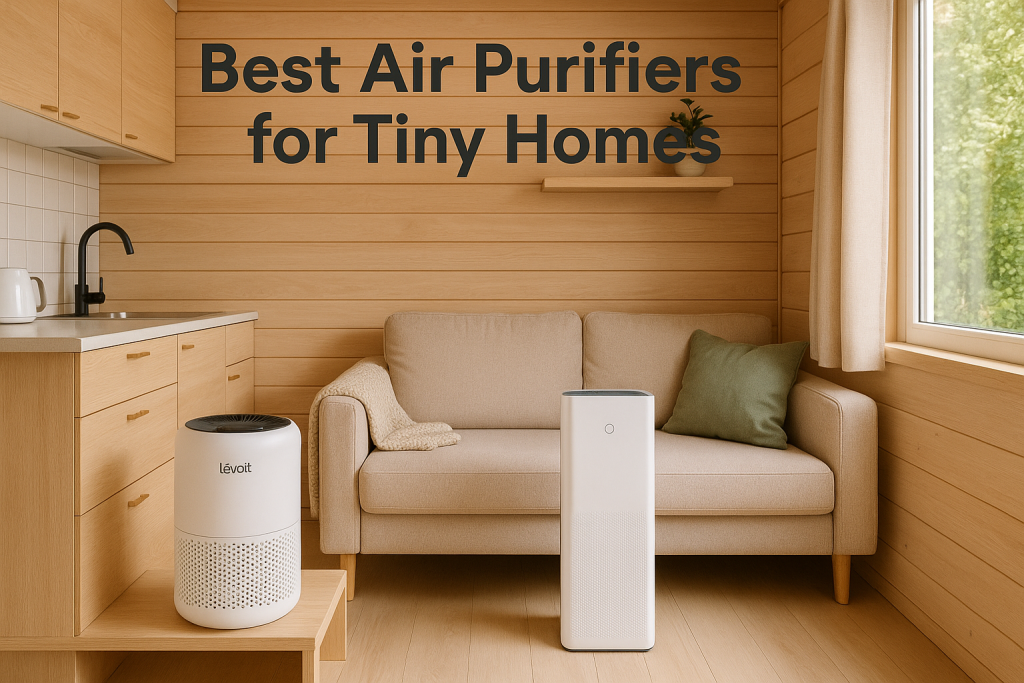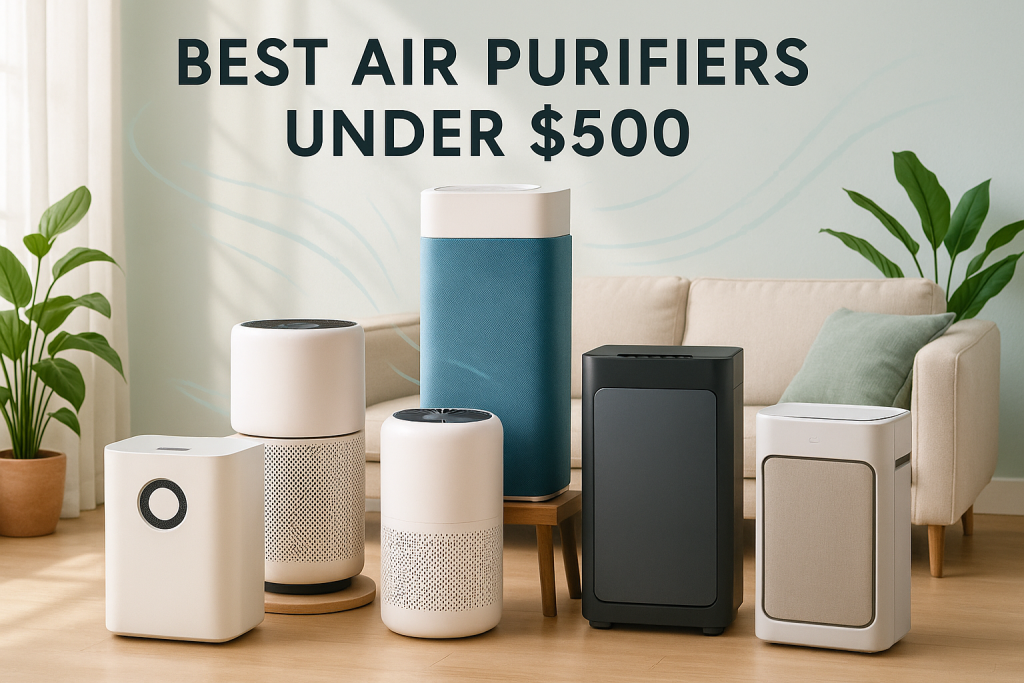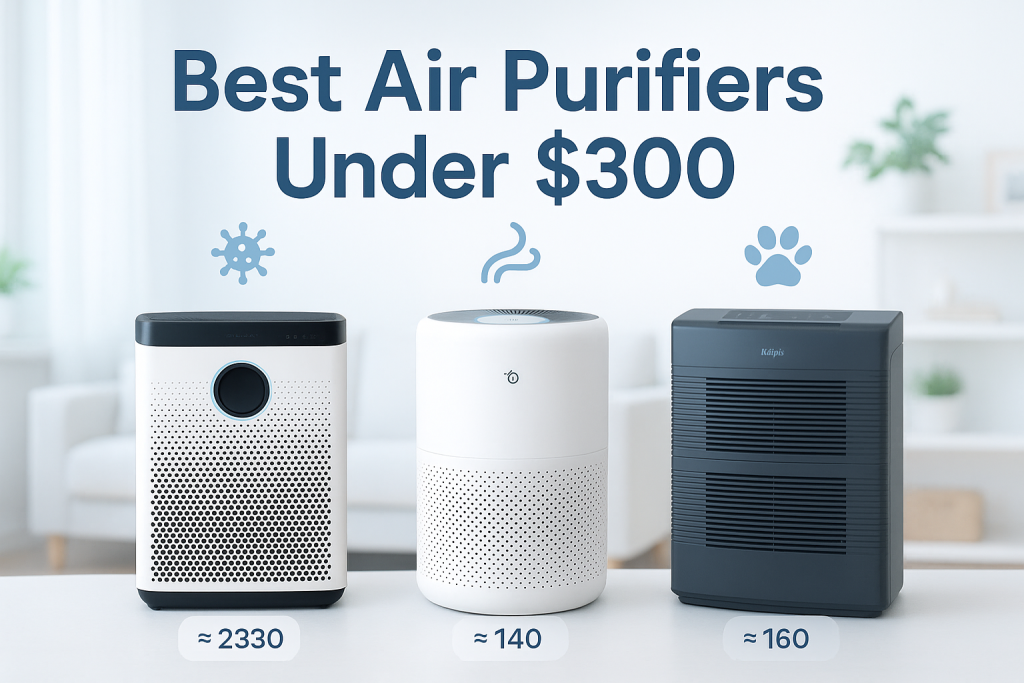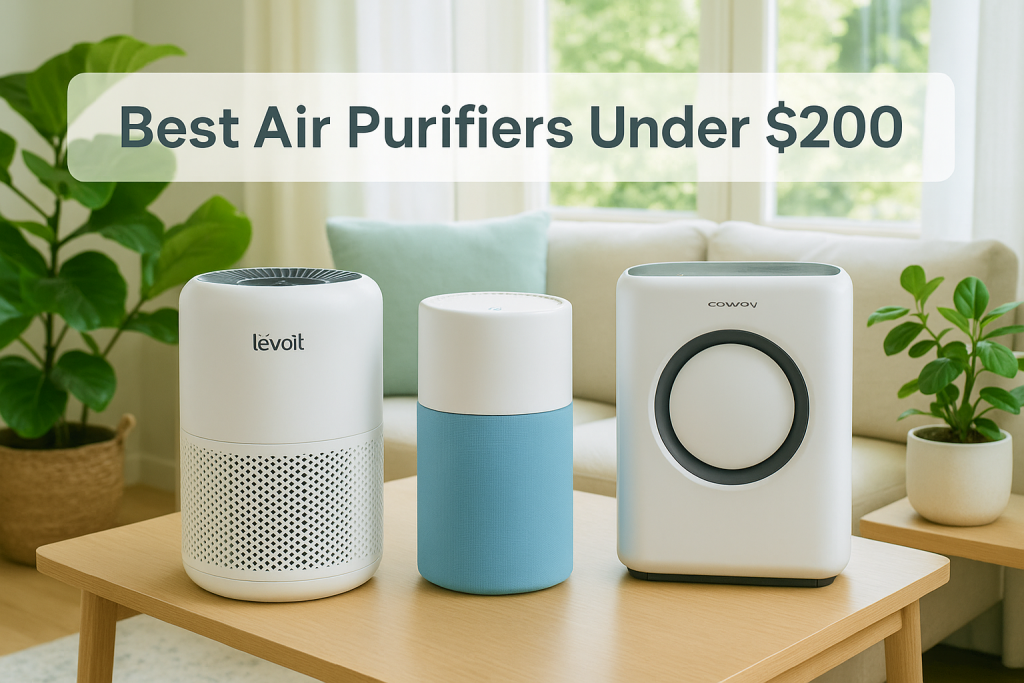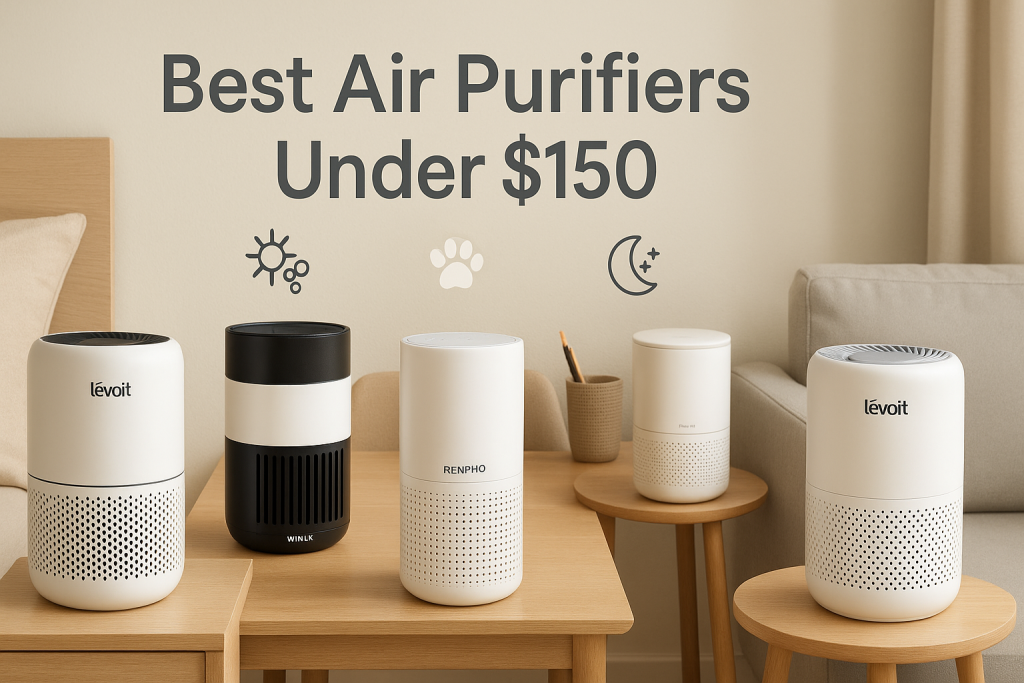Living in a tiny home presents unique air quality challenges. The smaller square footage concentrates pollutants, cooking odors, and moisture in a confined space where every inch matters. Finding the right air purifier for a tiny home requires balancing performance with space efficiency, noise levels, and energy consumption. These specialized air purifiers must work effectively without dominating your limited living area or draining your possibly restricted power supply. After consulting with tiny home experts and residents, we’ve compiled this comprehensive guide to help you breathe easier in your compact dwelling.
Unique Air Quality Challenges in Tiny Homes
Tiny homes present distinct air quality challenges that standard “small room” air purifiers aren’t necessarily designed to address. With typically less than 400 square feet of living space, air pollutants become more concentrated and potentially problematic in tiny home environments where proper air purification is essential.
Research shows that air exchange rates in tiny homes can be 2-3 times lower than in conventional houses when sealed for energy efficiency. This reduced ventilation means cooking fumes, moisture from showering, and off-gassing from building materials remain trapped inside longer.
Key air quality challenges in tiny homes include:
- Concentrated cooking odors and particulates in open floor plans
- Elevated moisture levels leading to potential mold issues
- Off-gassing from construction materials like plywood, composites, and adhesives
- Limited natural ventilation options due to fewer windows
- Pet dander and allergens in confined spaces
According to Dr. Maria Chen, environmental health specialist, “Confined living spaces can create a perfect storm for indoor air pollution. The EPA reports that indoor air can be 2-5 times more polluted than outdoor air, and this concentration effect can be amplified in tiny homes.”
Key Criteria for Selecting Air Purifiers in Tiny Homes
When evaluating air purifiers for a tiny home, standard metrics like CADR require reinterpretation based on your unique living situation. The EPA’s indoor air quality guidance for homes provides valuable baseline information, but tiny homes need more specialized considerations.
Most important factors for tiny home air purifiers:
- Space Efficiency: Footprint smaller than 12″ x 12″ or vertical/wall-mountable design
- Performance-to-Size Ratio: CADR rating of at least 100 for spaces under 400 sq ft
- Noise Level: Maximum 50 dB on high setting, under 30 dB on low/sleep mode
- Energy Consumption: Under 50 watts on standard setting, preferably with Energy Star rating
- Filter Efficiency: True HEPA filtration with at least 99.97% capture of 0.3-micron particles
- Versatility: Multi-stage filtration addressing particulates, odors, and VOCs
| Tiny Home Size | Recommended CADR | Max Energy Usage | Ideal Noise Level |
|---|---|---|---|
| 100-200 sq ft | 80-120 | 30-40W | <45 dB |
| 200-300 sq ft | 100-150 | 40-50W | <50 dB |
| 300-400 sq ft | 120-180 | 45-60W | <55 dB |
Best Overall Air Purifiers for Tiny Homes
These top-rated air purifiers offer the ideal balance of space efficiency, performance, and energy usage for tiny home living. Our tested picks for homes and offices include several models particularly well-suited for tiny spaces.
1. Levoit Core 300
The Levoit Core 300 strikes an excellent balance between performance and size, making it ideal for tiny homes.
- Dimensions: 8.7″ x 8.7″ x 14.2″ (compact cylindrical design)
- CADR: 141 CFM (smoke), 140 CFM (dust), 145 CFM (pollen)
- Power Usage: 45W maximum
- Noise Level: 24-50 dB
- Filter Lifespan: 6-8 months
- Price Range: $99-$110
Tiny Home Pros: Ultra-compact footprint, 360° air intake, true HEPA filtration, specialized filter options (pet, toxin, etc.), energy-efficient.
Tiny Home Cons: No smart features, requires floor space, not wall-mountable.
Lisa, a tiny home dweller in Colorado shares: “The Core 300 fits perfectly on my small shelf unit and keeps my 220 sq ft home fresh despite cooking in the same space I sleep. It’s quiet enough that I barely notice it running.”
2. Coway Airmega 150
The Airmega 150 features a slim profile design that’s perfect for tight spaces in tiny homes.
- Dimensions: 13.4″ x 6.5″ x 18.5″ (slim vertical design)
- CADR: 138 CFM (dust)
- Power Usage: 35W
- Noise Level: 20-48 dB
- Filter Lifespan: 6 months (pre-filter), 12 months (HEPA/carbon)
- Price Range: $149-$190
Tiny Home Pros: Space-saving slim design, filter replacement indicator, excellent energy efficiency, modern aesthetics.
Tiny Home Cons: Higher price point, not as versatile for specialty filtration.
Marco, who lives in a 180 sq ft tiny house on wheels, notes: “The Airmega’s narrow profile is perfect against my wall without jutting out into my walkway. It’s been a game-changer for dealing with humidity and cooking smells.”
3. GermGuardian AC4825E
The GermGuardian tower design makes efficient use of vertical space in tiny homes.
- Dimensions: 9″ x 5.5″ x 22″ (tall, slim tower)
- CADR: 108 CFM (dust)
- Power Usage: 55W
- Noise Level: 40-55 dB
- Filter Lifespan: 6-8 months
- Price Range: $85-$100
Tiny Home Pros: Budget-friendly, UV-C light kills airborne germs, minimal footprint, decent performance.
Tiny Home Cons: Slightly louder operation, higher energy consumption, less sophisticated filtration.
Amber from her 240 sq ft tiny home comments: “This purifier tucks into the corner perfectly and handles the dust from my nearby dirt road. The UV feature gives me extra peace of mind in such a small space.”
Vertical and Wall-Mountable Air Purifiers for Floor Space Optimization
In tiny homes where floor space is at an absolute premium, these vertical and wall-mountable options free up valuable square footage.
1. Rabbit Air MinusA2
- Dimensions: 21.4″ x 20″ x 7″ (wall-mountable)
- CADR: 200 CFM
- Coverage: Up to 815 sq ft
- Mounting: Wall-mountable with included kit or stand-alone
- Price Range: $550-$600
Installation Tip: For tiny homes on wheels, ensure mounting is on structural studs and use additional securing methods to prevent movement during transport.
2. BISSELL air320
- Dimensions: 8.3″ x 14.7″ x 25″ (slim vertical design)
- CADR: 150 CFM
- Filter System: Pre-filter, activated carbon, H13 HEPA
- Price Range: $280-$330
Tiny Home Advantage: The narrow design allows placement in tight corners while still delivering powerful filtration. Its furniture-like appearance blends with decor.
Ultra-Quiet Air Purifiers for Open-Concept Tiny Spaces
In an open-concept tiny home where sound travels freely, noise levels become particularly important when selecting an air purifier.
1. Blueair Blue Pure 411
- Dimensions: 8″ x 8″ x 16.7″
- Noise Level: 17-46 dB
- Sleep Mode: Yes, whisper-quiet at 17 dB
- Price Range: $120-$140
At its lowest setting, the Blue Pure 411 produces only 17 dB—quieter than rustling leaves (20 dB) and barely perceptible in most environments.
2. Winix AM90
- Dimensions: 15″ x 8.2″ x 23.6″
- Noise Level: 26-55 dB
- Sleep Mode: Auto-adjusting with light sensor
- Price Range: $220-$250
“As a light sleeper in my 180 sq ft loft bed tiny home, the AM90’s sleep mode has been perfect—I can’t hear it at all while sleeping, but I wake up without the congestion I used to have,” says Jamie, a tiny home owner in Oregon.
Best Air Purifiers for Off-Grid and Energy-Conscious Tiny Homes
For tiny homes operating with limited power resources, energy efficiency becomes a critical selection factor when choosing an air purifier.
1. Levoit Core 200S
- Power Consumption: 26W maximum
- Energy Efficiency: Energy Star certified
- Smart Features: App control for optimizing usage
- Price Range: $89-$99
The Core 200S consumes only 26W at maximum speed—less than many light bulbs—making it ideal for solar-powered tiny homes.
2. Hathaspace Smart Air Purifier
- Power Consumption: 40W typical
- Auto Mode: Adjusts speed based on air quality to conserve energy
- Price Range: $220-$250
Off-grid specialist Terry Wolfe explains: “For solar-powered tiny homes, every watt counts. Running a 40W purifier for 12 hours uses about 0.5 kWh—roughly 5% of a modest solar setup’s daily production. Look for units under 50W with auto-modes to maximize efficiency.”
3. Non-Electric Options
- Activated charcoal bags (strategic placement around tiny home)
- Beeswax candles (natural air cleaning properties)
- Himalayan salt lamps (minimal power usage)
These complementary solutions can reduce the need to run electric purifiers constantly, conserving precious power in off-grid situations.
Multi-Functional Air Purifiers for Tiny Homes
In tiny homes where every item must earn its keep, these multi-functional air purifiers provide additional benefits beyond air cleaning.
1. Dyson Pure Hot+Cool HP04
- Functions: Air purifier + heater + cooling fan
- Coverage: Up to 800 sq ft
- Filtration: HEPA + activated carbon
- Price Range: $570-$650
“The Dyson triple-function unit replaced three separate appliances in my tiny home, saving me about 6 square feet of precious floor space,” reports Chris, a tiny home dweller in Minnesota. “The upfront cost was high but worth it for the space savings alone.”
2. Honeywell HPA100 with Top Platform
- Functions: Air purifier + small shelf/storage
- Dimensions: 10″ x 13″ x 13.94″
- Modified Use: Flat top supports up to 10 lbs for plants or storage
- Price Range: $110-$140
The flat top of this unit makes it perfect for creating additional surface area in a tiny home—many users report placing small plants, books, or decorative items on top.
Optimal Air Purifier Placement in Tiny Home Layouts
Where you position your air purifier in a tiny home can dramatically impact its effectiveness due to the compact air circulation patterns. Proper placement is especially crucial in open plan home designs where air flows freely between living spaces.
Standard Rectangular Tiny Home
For a basic rectangular layout, place the purifier in the center of the longest wall, at least 12 inches from any surface. This allows maximum air circulation throughout the space.
Tiny Home with Loft
Hot air rises, carrying pollutants to the loft area. Position a compact purifier in the loft for sleeping, with a second unit on the main level near cooking areas. If using only one unit, place it on the main level near the loft ladder/stairs to capture rising air.
L-Shaped Tiny Home
Place the purifier at the inside corner of the “L” where the two sections meet. This strategic position allows filtered air to flow into both areas.
Vertical Placement Strategy
In tiny homes with high ceilings, consider placing purifiers at different heights:
- Floor level: Best for dust and pet dander
- Counter height: Ideal for cooking odors and mid-level pollutants
- Elevated shelf: Effective for pollen and airborne particles
Warning: In tiny homes, avoid placing purifiers in “dead zones” like deep corners or behind furniture. Even a few inches of obstruction can significantly reduce airflow in such confined spaces.
DIY and Budget Air Purification Solutions for Tiny Homes
Creating effective air purification in a tiny home doesn’t always require an expensive dedicated unit—these DIY approaches can complement or substitute commercial options.
Box Fan HEPA Hack
Materials needed:
- 20″ box fan ($20-30)
- 20″ x 20″ MERV 13 filter ($10-15)
- Duct tape
Assembly:
- Attach the filter to the intake side of the fan (usually the back)
- Seal edges with duct tape for an airtight fit
- Replace filter every 1-3 months depending on air quality
Tiny Home Adaptation: Use a smaller 12″ box fan for tight spaces, or mount the setup vertically on a wall to save floor space.
Budget-Friendly Commercial Options
- LEVOIT LV-H132: $50-60
- Hamilton Beach TrueAir: $60-70
- KOIOS Air Purifier: $50-60
“My DIY box fan filter cost about $35 total and filters nearly as effectively as my friend’s $200 unit, based on our dust tests,” notes Sam, a tiny home builder. “The trade-off is more noise and less attractive appearance, but it’s perfect for those on a budget.”
Addressing Specific Air Quality Issues in Tiny Homes
Tiny homes often face concentrated versions of common air quality issues that require targeted solutions. Different pollutants like PM2.5 particles require specific purification approaches.
Cooking Odors in Open-Concept Layouts
Recommended Solution: Winix 5500-2 with enhanced carbon filtration or Blueair Blue Pure 211+ with washable pre-filter.
Placement Strategy: Position 4-6 feet from cooking area, not directly adjacent, to allow proper air circulation before filtration.
Moisture and Humidity Management
Recommended Solution: Combined purifier/dehumidifier like the Midea 3-in-1 or a separate dehumidifier plus purifier.
Environmental scientist Dr. James Rivera notes: “Tiny homes can quickly develop humidity problems from cooking, showering, and even breathing. A unit that addresses both air quality and moisture is ideal for spaces under 300 square feet.”
Pet Dander in Confined Spaces
Recommended Solution: Levoit Core 300 with Pet Allergy Filter or a specialized air purifier for allergies with enhanced dander capture.
Enhanced Strategy: Add washable slipcovers to furniture, use HEPA vacuum weekly, and create a dedicated pet grooming station outside when possible.
Construction Material Off-Gassing
New tiny homes often have concentrated VOCs from building materials. A formaldehyde-specific air purifier can help address these chemicals that commonly off-gas from new construction.
Recommended Solution: Austin Air HealthMate Plus or Airpura V600 with enhanced VOC filtration.
Timeline: Most intense off-gassing occurs in first 6 months; run purifier at high settings during this period.
Seasonal Air Purification Strategies for Tiny Homes
Air quality challenges in tiny homes change dramatically with the seasons, requiring adaptable purification approaches.
Winter Strategy
- Primary Challenge: Sealed environment with limited fresh air exchange
- Purifier Setting: Run continuously at medium speed
- Focus: VOC and odor filtration become more important
- Complementary Technique: Brief daily ventilation (15 minutes) even in cold weather
Summer Strategy
- Primary Challenge: Humidity and possible wildfire smoke
- Purifier Setting: High during peak pollution times, AUTO mode otherwise
- Focus: Particle filtration and dehumidification
- Complementary Technique: Run purifier at high speed before closing windows at night
Spring Strategy
- Primary Challenge: Pollen and seasonal allergies
- Purifier Setting: High during high pollen count days
- Focus: Enhanced HEPA filtration
- Complementary Technique: Keep windows closed during peak pollen hours (typically morning)
“In my off-grid tiny home in Montana, I swap filter types seasonally—carbon-focused in winter for cooking odors and wood stove smoke, HEPA-focused in spring for pollen, and a combined approach during fire season,” explains Heather, a 5-year tiny home resident.
Maintenance and Filter Replacement in Tiny Home Environments
Maintaining air purifiers in tiny homes requires special consideration due to concentrated dust, limited storage for replacement filters, and space constraints during cleaning.
Accelerated Maintenance Schedule
- Pre-filters: Clean weekly instead of monthly (higher dust concentration)
- HEPA filters: Replace every 4-6 months instead of 6-8 months
- Carbon filters: Replace every 3 months if cooking frequently in the space
Space-Efficient Filter Storage
- Store replacement filters in vacuum-sealed bags under furniture
- Use vertical storage solutions (wall-mounted filter holders)
- Schedule auto-deliveries to eliminate need for storing extras
“In my 180 sq ft tiny house, I clean my pre-filter twice as often as recommended because cooking and living in the same small space creates more particulates,” says Mia, a tiny home owner in Washington. “The extra maintenance is worth it for consistently clean air.”
Real Tiny Home Case Studies: Air Purification Solutions
See how actual tiny home dwellers have solved their air quality challenges with creative purification strategies.
Case Study 1: Alex’s Stationary Tiny Home (240 sq ft)
Challenge: Woodworking hobby creating fine dust in living space
Solution: Combination approach with Coway Airmega 150 running continuously plus dedicated air filtration during woodworking sessions
Results: 82% reduction in measurable particulates and elimination of wood dust on surfaces
Cost: $189 for purifier + $35 quarterly for replacement filters
Case Study 2: Sarah’s Mobile Tiny Home on Wheels (180 sq ft)
Challenge: Changing air quality as home moves between urban and rural locations
Solution: Compact Winix A230 with air quality monitor to adjust settings based on location
Results: Consistent air quality regardless of external environment
Cost: $130 for purifier + $60 for separate air quality monitor
Case Study 3: Jordan’s Off-Grid Desert Tiny Home (320 sq ft)
Challenge: Desert dust and limited solar power capacity
Solution: Levoit Core 200S programmed to run at night when solar batteries have excess capacity
Results: Maintains clean air while using only 0.3kWh daily
Cost: $89 for purifier + $45 annually for replacement filters
Frequently Asked Questions About Air Purifiers in Tiny Homes
Do I need a special air purifier for a tiny home?
While you don’t need a “tiny-home-specific” model, you should select purifiers with a smaller footprint, lower noise levels, and appropriate CADR for your limited square footage. Space efficiency and power consumption are more critical in tiny homes than in standard dwellings.
Can one air purifier effectively clean a whole tiny home?
Yes, a single properly-sized air purifier can effectively clean a typical tiny home under 400 sq ft, especially in open floor plans. For homes with separate rooms or lofted sleeping areas, strategic placement or a second compact unit may be beneficial.
How do I manage noise in such a small space?
Look for units with sleep modes under 30 dB, position the purifier away from sleeping/working areas when possible, and run at higher speeds only when you’re away or the noise won’t be disruptive. Some users report that consistent low-level purifier noise actually helps mask other sounds in tiny homes.
What about energy usage for off-grid situations?
For off-grid tiny homes, select purifiers using less than 50W on standard settings and models with auto-modes that adjust based on air quality. Calculate daily power consumption (Watts × hours ÷ 1000 = kWh) to ensure compatibility with your energy system.
How should I place an air purifier in a lofted sleeping area?
For lofted sleeping areas, use a compact model (under 12″ tall) placed at least 12″ from walls. Ensure unrestricted airflow and consider wall-mounting options to preserve precious floor space. Some tiny home dwellers install small shelves specifically for loft purifiers.
Are there multi-purpose air purifiers for tiny homes?
Yes, consider models that combine air purification with heating, cooling, humidification, or dehumidification. These multi-function units save valuable space in tiny homes, though they typically cost more upfront and may consume more power than single-function devices.
How often will I need to replace filters in a tiny home environment?
Filter replacement is typically more frequent in tiny homes—approximately 25-50% more often than manufacturer recommendations due to concentrated pollutants in a smaller space. Pre-filters may need cleaning weekly rather than monthly, especially with cooking, pets, or hobbies generating particulates.
| Photo | Air Purifier Model | Best for | Price |
|---|---|---|---|

|
WINIX A231 Air Purifier | Asthma & Indoor Pollution | Check Price On Amazon |

|
Rabbit Air, A3 SPA-1000N Air Purifier | Pet Dander & Odors | Check Price On Amazon |

|
LEVOIT Air Purifier | Best Overall | Check Price On Amazon |

|
GermGuardian Air Purifier | Cigarette & Cooking Smoke | Check Price On Amazon |

|
Coway Airmega Air Purifier | New-borns | Check Price On Amazon |

|
BLUEAIR Air Purifier | Germ & Virus Control | Check Price On Amazon |
